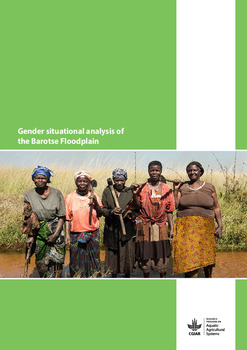Gender situational analysis of the Barotse Floodplain

Citation
Kwashimbisa, M.; Puskur, R. (2014). Gender situational analysis of the Barotse Floodplain. CGIAR Research Program on Aquatic Agricultural Systems. Penang, Malaysia. Program Report: AAS-2014-43
Zambia's rivers, lakes and wetlands support extensive agriculture, fisheries and livestock production and contribute to the livelihoods of about 3 million people or 25% of the country's population. These aquatic agricultural systems are particularly important to poor people and provide significant opportunities for agriculture-based economic growth. The majority (72%) of the Zambian population is engaged in agricultural activities, of which almost 65% are women. There is now widespread recognition of the importance of gender and development. This is reflected in the growing prominence of gender strategies for development organizations and their programs, the emergence of compelling approaches for gender integration and the development of indicators for tracking outcomes of research and development interventions. This analysis, based on information gathered from both female and male farmers of different age groups, attempts to provide a glimpse into aspects that have not been widely studied in agricultural research. The knowledge generated here is expected to shape the planned research interventions in AAS that aim to reduce gender disparities in access to resources, but also address social and behavioural change at various levels to tackle the causes of these inequities.
Permalink
Date Available
Type
Publisher
Countries
Copyright
CC BY 4.0
Research Themes
Topics